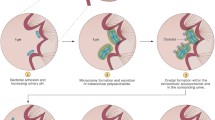Summary
Urinary stones form as a consequence of urinary supersaturation. Supersaturation occurs as a result of elevated concentrations of urinary solutes. Dietary, metabolic, endocrine, hereditary, and infectious processes alter urinary solute concentrations. Struvite (MgNH4PO4. 6H2O) and carbonate-apatite [Ca10(PO4)6CO3]stones form in urine that becomes supersaturated as a by-product of the hydrolysis of urea by the bacterial enzyme urease. Urease-induced stones manifest primarily as branched renal calculi and as bladder calculi. Conventional therapy has usually consisted of surgical removal of the stone combined with a short course of antimicrobial therapy. Such treatment is curative in about 50% of cases. Recurrent stone formation and progressive pyelonephritis occur in those who are not cured. Adjunctive medical treatment with acetohydroxamic acid or hydroxyurea lessens the risk of calculogenesis and decreases growth of residual stones in patients who are not cured by conventional therapy. Patients with urea-splitting urinary infection and renal stones have a major life-threatening disease. The morbidity and expense that result from this disease are great. Long-term (perhaps lifetime) chemotherapy with antimicrobial agents and/or urease-inhibiting drugs combined with judicious and expert surgical intervention can be expected to significantly improve the plight of these unfortunate patients.
Similar content being viewed by others
References
Adams, F.: The Genuine Works of Hippocrates. New York: William Wood and Co. 1929
Brown, T. R.: On the relation between the variety of microorganisms and the composition of stone in calculous pyelonephritis. Journal of the American Medical Association 36, 3195–1397 (1901)
Butt, A.J.: Etiologic Factors. In: Renal Lithiasis. Springfield: Chas. C. Thomas Co. 1956
Fishbein, W.N.: Excretion and hematologic effects of single intravenous hydroxyurea infusions in patients with chronic myeloid leukemia. Johns Hopkins Medical Journal 121, 1–8 (1967)
Fishbein, W. N., Carbone, P. P.: Urease catalysis. II. Inhibition of the enzyme by hydroxyurea, hydroxylamine and acetohydroxamic acid. Journal of Biological Chemistry 240, 2407–2414 (1965)
Fishbein, W. N., Daly, James E.: Urease inhibitors for hepatic coma. II. Comparative efficacy of four lower hydroxamate homologs in vitro and in vivo. Proceedings of the Society for Experimental Biology and Medicine 134, 1083–1090 (1970)
Griffith, D.P.: Struvite stones. Kidney International 13, 372–382 (1978)
Griffith, D. P., Gibson, J. R., Clinton, C. W. Musher, D. M.: Acetohydroxamic acid: clinical studies of a urease inhibitor in patients with staghorn renal calculi. Journal of urology 119, 9–15 (1978)
Griffith, D. P., Moskowitz, P. A., Carlton, C. E.: Adjunctive chemotherapy of infection-induced staghorn calculi. Journal of Urology, in press (1979)
Griffith, D. P., Musher, D. M., Itin, C.: Urease: The primary cause of infection-induced stones. Investigative Urology 13, 346–350 (1976)
Hagar, B. H., Magrath, T. B.: The etiology of incrusted cystitis with alkaline urine. Journal of the American Medical Association 85, 1352–1355 (1925)
Lamm, D. L., Johnson, S. A., Friedlander, A. M., Gittes, R. F.: Medical therapy of experimental infection stones. Urology 10, 418–421 (1977)
Phillips, F. S., et al.: Hydroxyurea. I. Acute cell death in proliferating tissues in rats. Cancer Research 27, 61 (1967)
Sing, M. J. B., Chapman, R., Tresidder, G. C., Blandy, J.: The fate of the unoperated staghorn calculous. British Journal of Urology 45, 581 (1973)
Smith, M. J. V.: Hydroxyurea and infected stones. Urology 11, 274–277 (1978)
Wojewski, A., Zajaczkowski, T.: The treatment of bilateral staghorn calculi of the kidneys. International Urology and Nephrology 5, 249–260 (1974)
Author information
Authors and Affiliations
Additional information
Supported in part by grants from the Veterans Administration, the Urolithiasis Laboratory and NIH Grant 1 RO 1 AM20159-O1A1
Rights and permissions
About this article
Cite this article
Griffith, D.P. Urease stones. Urol. Res. 7, 215–221 (1979). https://doi.org/10.1007/BF00257208
Accepted:
Issue Date:
DOI: https://doi.org/10.1007/BF00257208




